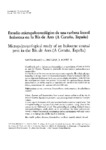Estudio micropaleontológico de una turbera litoral holocena en la Ría de Ares (A Coruña, España)

View/
Use this link to cite
http://hdl.handle.net/2183/6154Collections
Metadata
Show full item recordTitle
Estudio micropaleontológico de una turbera litoral holocena en la Ría de Ares (A Coruña, España)Alternative Title(s)
Mieropaleontologieal study of an holoeene eoastal peat in the Ría de Ares (A Coruña, España)Date
1993Citation
Cadernos do Laboratorio Xeolóxico de Laxe, 1993, 18: 175-188 ISSN: 0213-4497
Abstract
[Resumen] El análisis de polen, diatomeas y foraminíferos de un sedimento litoral en la Ría de Ares (A Coruña, España) ha permitido interpretaciones paleoambientales
comparables. Se trata de un sedimento turboso con macrorrestos vegetales. El análisis micropaleontológico de este nivel y las dataciones absolutas sitúan la formación del mismo en el período Subboreal. La lectura paleoecológica obtenida a través del estudio micropaleontológico nos permite reconstituir dos paleoambientes fundamentalmente: un medio continental vegetado y un ambiente con condiciones salobres, consecuencia del aumento del nivel del mar. [Abstract] Pollen, diatoms and foraminifera from a raised marine sediment of the Ría de Ares (A Coruña, Spain) area produced comparable paleoenvironntental interpretations. It is an organic formation with peat associated with numerous vegetal rests. The micropaleontological analysis of this level and the absolute dating, place its formation in the Subboreal periodo The paleoecological reading obtained from a micropaleontological study allows us to reconstitute two basic paleoenvironments: a vegetal continental environment and an environment with salty conditions, as a consequence of the sea level increase
Keywords
Polen
Diactomeas
Foraminíferos
Niveles marinosico español
Pollen
Diatoms
Foraminifera
Sea level
Spanish atlantic litoral
Diactomeas
Foraminíferos
Niveles marinosico español
Pollen
Diatoms
Foraminifera
Sea level
Spanish atlantic litoral
ISSN
0213-4497





